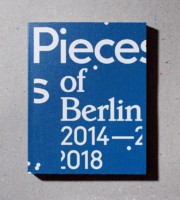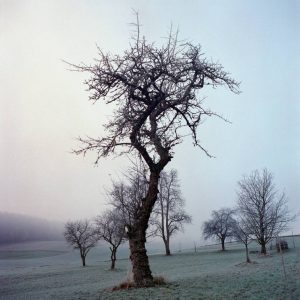BERLIN PHOTOGRAPHER FLORIAN REISCHAUER
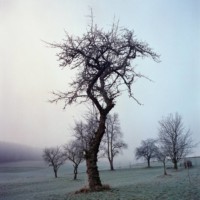
(An intriguing photo from Florian Reischauer’s project GRÜß GOTT — A FAIRY TALE)
***
My interview today is with the talented, Berlin-based photographer Florian Reischauer, whose award-winning PIECES OF BERLIN project features retro-style photos of individual Berliners along with expressions of their thoughts about life today in the German capital.
Following PIECES OF BERLIN is a great way for people interested in the city to keep up with day-to-day life there.
Without further ado, here is my interview with Florian Reischauer.
When you were growing up in Ried im Innkreis, Austria, what notions did you have about Berlin, and what informed those notions? Did you hear about the city from other people, or see movies or read books set there?
Ried im Innkreis, where I attended high-school, is a small town of 13,000 inhabitants. Back then, my sights were set on moving to Vienna after graduation. I’m too young to have an active memory of the fall of the Berlin Wall; nonetheless, that historical moment wound up attached to my thinking about Berlin in my early adulthood.
Later on, books like Sven Regener’s novel BERLIN BLUES — (the German title is HERR LEHMANN) — nourished my ever-increasing fascination with the city.
(Ed. — Sven Regener’s novel HERR LEHMANN has sold over one million copies and was the basis for the movie directed by Leander Haußmann.)
Where in Vienna did you study photography and how did you enjoy living in that city?
To discover and pursue my many interests in an urban setting felt extremely liberating!
I first lived in Vienna while completing my year of Zivildienst, civilian service.
Subsequently, I studied at an institution colloquially known as “Die Graphische.” The school’s formal name is a real mouthful: It’s the Higher Graphical Federal Education and Research Institute. In German, it’s Die Höhere Graphische Bundes-Lehr- und Versuchsanstalt.
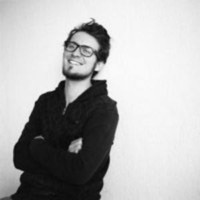
(Florian Reischauer)
Before you moved to Berlin, were you naturally sociable? Not everybody would be inclined to meeting and talking with new people all the time the way you do for Pieces of Berlin.
I moved to Berlin in 2007 upon completion of my studies in Vienna, which had perhaps come to seem a size too small for me. And, I simply felt I wanted change. Believe it or not, before deciding to move to Berlin, I hadn’t even ever been there. But I heard so much about the open-mindedness reigning in the city, the unpolished edges, and of course, its being a playground where you can try yourself out.
So, I fell immediately in love with Berlin. It was perfect for me! I felt I had a new Heimat.
However, when I first moved to Berlin, I didn’t know anybody in the city. A mixture of loneliness and curiosity led to my starting the Pieces of Berlin project. As turned out, I love getting to know new people and listening to their opinions about things.
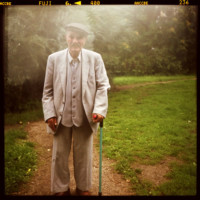
(A photo characteristic of Florian Reischauer’s PIECES OF BERLIN)
Your PUBLIC VIEWING project featured outsized, Polaroid-like photos of individuals exhibited on outside walls of buildings in Berlin. Please tell us a little about it.
I was motivated to play with public spaces by installing distinctive, off-beat and, you could say, challenging images that provoke questions for passersby, breaking up their daily routines. Think of these PUBLIC VIEWING photos as a non-commercial counterpoint to the everyday visual bombardment of billboard and other advertising, trying to get us to buy things or otherwise consume goods and services.
Instead, my PUBLIC VIEWING images get people to ask themselves “Why is the person in that photo staring at me? What are they trying to say?”
Another aspect of this project is that of juxtaposed contrasts. The portraits were taken in a completely dark room. The models, friends of mine, were half naked and did not know exactly when the shutter would be pressed. I liked the idea of bringing this intimate, vulnerable moment into the public urban space.
As this project was one expression of my own situation — arriving in Berlin to start a new chapter in my life — it’s also a very personal work.
Your GRÜß GOTT — A FAIRY TALE project features haunting images of people and places near your hometown, Ried im Innkreis. Please tell us i) a little about the technical considerations that went into your creation of those photos; and also ii) why you chose to show relatively stark natural settings and/or individuals framed in stark natural settings rather than to show people near or inside structures typical of the region.
I used a 6×6 medium format camera which allows me to show a certain depth and stability.
I think of these photographs as showing a rather closed society and environment that has stability and durability but which is not so easy to become a part of, if you are from the outside. While that rural society has many rather strict rules by which one must abide, it’s also true that people there must get along with pretty much everybody else, whatever attitudes they may nurse.
With this photo project, then, I invite viewers on a journey into this small social microcosm, this village, and let them “play,” as it were, with various aspects of it.
Regarding the settings, I chose these particular sites because I wanted to focus on the protagonists’ pure essence, without any of the distracting details of their houses and homes, which, I felt, would wind up creating very different and individualized narratives. Instead, the people portrayed can be seen as iconic samples of certain groups within village society.
For your PIECES OF BERLIN project, the write-ups accompanying each featured individual contain the individual’s thoughts only. I’m wondering, though, when you take a photo and conduct your interviews, is there back and forth, to draw out specific information, i.e. do you ask people a number of different questions?
For the first 5 years, I wrote a summary of each interview, narrated from my point of view. Then I changed to first person narration, to get the reader more directly involved with the featured individual.
Each interview starts with the same questions about who the person is and their relationship with Berlin. Things can develop in different directions, sometimes remaining more ‘everyday’ and other times becoming very personal. It all depends on the individual subject, how they open up and how much time they have.
And that variety is what I enjoy most about these encounters. It’s challenging to establish trust in a very short time, convincing a stranger to become part of this project. But the evolution of each interview is a fascinating and exciting thing for me.
Please feel free to add anything else you would like my readers to know about your work.
Because Berlin changes so rapidly and is endlessly interesting, Pieces of Berlin is an open-ended project, allowing me to keep my finger on the pulse of the city. I’m hoping that Berlin always retains its rebellious, edgy character and remains a Heimat for artistic, free-spirited people.
***
Find Florian Reischauer’s latest additions to PIECES OF BERLIN here.
PIECES OF BERLIN is here on Twitter, and here on Facebook.
For a video of Florian Reischauer’s appearance at New York University, go here.
To learn more about all of Florian Reischauer’s photography projects, go here.
Note that the PIECES OF BERLIN project has twice been gathered into book-length volumes.
